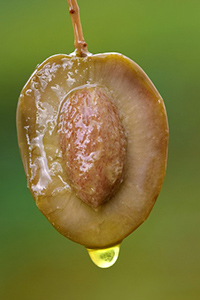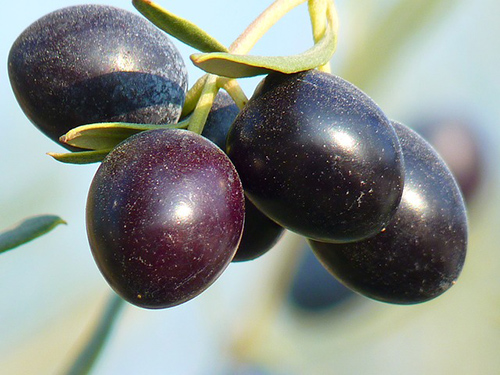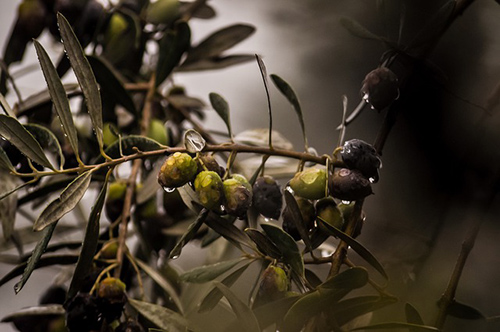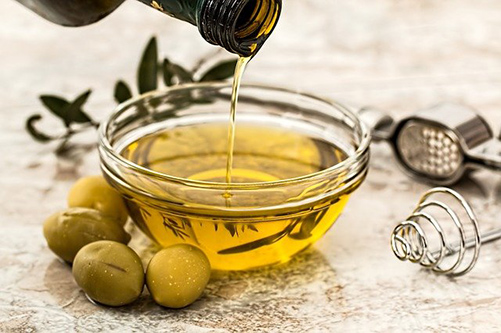Contents

The olive tree is an essential part of Mediterranean culture. The Phoenicians and Romans spread it all over the Mediterranean coast. Olive oil is still the most popular edible fat in southern Europe, accompanying bread, salads, and many other tasteful meals.
According to the Spanish researcher Grande Covian, the consumption of olive oil instead of butter explains the lower frequency of heart attacks and thrombosis among Mediterranean people compared to those of central and northern Europe and North America.
Spain is ranked first in the production of olive oil, with 180 million olive trees spread from Andalusia to Catalonia. There are several kinds of olive oil:
- Virgin olive oil: This oil is obtained from olives that have been matured (mashing), cold-pressed, decanted and filtered, or centrifuged. It does not undergo any chemical treatment.
- Pure olive oil: A mixture of virgin and refined olive oils, the latter undergoing a physical-chemical process to decrease its degree of acidity.
- Pump Up The Positives: You’re probably already aware of the health benefits of olive oil, but it’s obviously unhealthy and impractical to ingest a bunch of oil. Now you can get those same advantages through the best non-GMO Olive Leaf capsule taken just once daily.
Virgin olive oil is more natural and has a more robust taste, while “pure” olive oil or refined olive oil has a more neutral flavor. All oils, especially virgin oil, are superior to seed oils (sunflower, corn, etc.), considering their nutritional value, medicinal properties, and stability in frying.

Olive Tree Scientific Facts
- French: Olivier.
- Spanish: Olivo.
- Environment: Native to the Middle East, it grows wild and farmed in all Mediterranean countries; it was introduced to America in the 16th century.
- Description: A medium-built tree of the Oleaceae family, it has a gross, winding trunk, elliptical, straight-bordered, grey-green leaves, and tiny, whitish flowers. Its fruit is the well-known olive berry. The wild olive tree is smaller, with rounded leaves and smaller fruits than the farmed olive tree; however, it is equally juicy.
- Parts of the plant used medicinally: The leaves and the fruits.
Healing Properties and Indications

The leaves of the olive tree contain oleuropein, a glycoside; they also contain tannins, sugars, and other substances. They are febrifuge and hypotensive, constituting one of the most effective vegetal remedies against high blood pressure. Their use is also adequate in the case of arteriosclerosis.
Olives contain fats, proteins, mineral salts (especially calcium), enzymes, and vitamins A, B1, B2, and P. They are appetizing, digestive stimulating, and mild laxative. Olive oil contains a mixture of several lipids, chemically formed by the union of glycerine with the so-called fatty acids, the most important of which is the oleic acid, followed by linoleic, palmitic, and stearic acids, among others. It has the following properties:

- Emollient exerts a soothing and anti-inflammatory effect on the skin and the mucous membrane. It heals burns, wounds, ulcers, and skin irritations. It is part of many ointments and lotions. When taken orally, it has an anti-inflammatory and protective effect on the stomach mucosal membrane. However, it is an excellent remedy in cases of acute gastritis, often caused by medicines such as aspirin or alcoholic beverages, coffee, spices, or pickles.
- Mild laxatives: Furthermore, they ease the expulsion of intestinal parasites.
- Cholagogue promotes gall bladder emptying, thus alleviating abdominal discomfort due to gall bladder dysfunctions. Moreover, the bile that flows in the intestine eases digestion. However, it must be carefully used in cholelithiasis (gall stones) because it may provoke gall bladder and liver colic.
- Effects on cholesterol: Olive oil does not reduce the level of cholesterol in the blood as strongly as wheat germ or corn oil. However, continuous use can keep the level of cholesterol in the blood low. It has been proven that olive oil increases the high-density lipoprotein (HDL), which transports a type of cholesterol called HDL cholesterol in the blood. This type of cholesterol prevents arteriosclerosis, unlike the cholesterol associated with low-density lipoproteins (LDL) or harmful cholesterol. This may explain why the chronic consumption of olive oil as a dietary fat is directly related to a lower risk of heart attacks.
- Antitoxic, except in poisoning caused by phosphorus or its derivatives. The victim must drink a glass of oil mixed with warm water to induce vomiting. After vomiting, some spoonfuls of oil are given to the patient, acting as an antidote in the digestive system.
Olives have been used medicinally and as food for centuries. In internal applications, a decoction of the tree’s inner bark or leaves is an effective remedy against fevers. An infusion of olive leaves has excellent benefits and a calming effect on nervous people.
Olive oil increases bile secretion and is a laxative, promoting muscular bowel contractions. It soothes mucus membranes and is believed to dissolve cholesterol. The leaves can aid the system in resisting colds and flu. Olive oil is excellent for many infectious diseases and can fight parasites, fungi, viruses, and bacteria. It appears to have a positive effect on blood pressure.
Olives can also be used for chronic fatigue syndrome, diarrheal diseases, psoriasis, and inflammatory arthritis. In external applications, olive oil treats intense itching, bruises, burns, sprains, and insect bites. When combined with rosemary, it can also treat dandruff.
NOTE: Olive oil is regularly used as a base for ointments and salves. Cold-pressed olive oil is best.
The Olive Oil and The Skin

In ancient times, when today’s wide variety of beauty products did not exist, olive oil was one of the most appreciated cosmetic products. In the ancient land of Israel, as in other Mediterranean cultures, the habit of anointing the head with olive oil to make the skin and hair more beautiful was widely spread.
All oils, especially olive oil, have a soothing and protective action on the skin that absorbs them. An excellent method to apply olive oil to the skin is:
- Make a lotion with olive oil and softly rub it on the whole body.
- Put on a gown and wait for 15-20 minutes.
- After this, take a warm shower using your usual soap. After towel drying, the skin will be softer and firmer.
How to use the Olive Tree
- Decoction
- Olives are taken as an appetizer, in salads, or during meals.
- Olive oil should be taken in one or two teaspoonfuls on an empty stomach before meals. It is preferable that it is virgin olive oil and, if possible, extracted by cold pressure or decantation.
- Olive oil is also applied as a lotion or cream (ointment).
- Enema: Mix warm water and olive oil, half and half. A decoction of high mallow or althea may be added.
Infusion: Steep one to two teaspoons of leaves in one cup of water for ten minutes and take two teaspoons. Decoction: Boil two handfuls of leaves or bark in one quart of water until one cup of liquid remains. Oil: As a laxative, take one to two fluid ounces, and as a cholagogue, take one to two teaspoons at a time.
DISCLAIMER: All content on this website is presented solely for educational and informational objectives. Do not rely on the information provided as a replacement for advice, diagnosis, or treatment from a qualified medical expert. If you are pregnant, nursing, or have any preexisting medical concerns, talk to your doctor before using any herbal or natural medicines.
REFERENCES
- George D. Pamplona-Roger, M.D. “Encyclopedia of Medicinal Plants.” George D. Pamplona-Roger, M.D. Encyclopedia of Medicinal Plants. Ed. Francesc X. Gelabert. vols. 1 San Fernando de Henares: Editorial Safeliz, 2000. 239,240,241. Print. [olive tree health benefits]
- Vance Ferrell Harold M. Cherne, M.D. The Natural Remedies Encyclopedia [Book]. – Altamont, TN: Harvestime Books, 2010. – Vol. Seventh Edition: 7: pp. 171.
- https://www.verywellhealth.com/the-benefits-of-olive-leaf-extract-89489
- https://www.realsimple.com/health/preventative-health/olive-leaf-extract-benefits
Last update on 2025-06-04 / Affiliate links / Images from Amazon Product Advertising API






